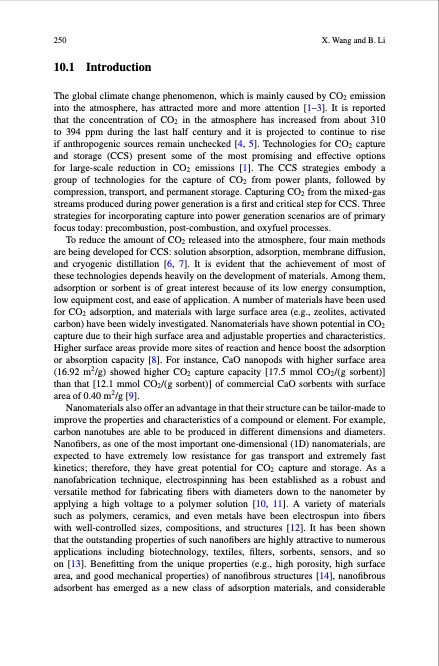
PDF Publication Title:
Text from PDF Page: 002
250 X. Wang and B. Li 10.1 Introduction The global climate change phenomenon, which is mainly caused by CO2 emission into the atmosphere, has attracted more and more attention [1–3]. It is reported that the concentration of CO2 in the atmosphere has increased from about 310 to 394 ppm during the last half century and it is projected to continue to rise if anthropogenic sources remain unchecked [4, 5]. Technologies for CO2 capture and storage (CCS) present some of the most promising and effective options for large-scale reduction in CO2 emissions [1]. The CCS strategies embody a group of technologies for the capture of CO2 from power plants, followed by compression, transport, and permanent storage. Capturing CO2 from the mixed-gas streams produced during power generation is a first and critical step for CCS. Three strategies for incorporating capture into power generation scenarios are of primary focus today: precombustion, post-combustion, and oxyfuel processes. To reduce the amount of CO2 released into the atmosphere, four main methods are being developed for CCS: solution absorption, adsorption, membrane diffusion, and cryogenic distillation [6, 7]. It is evident that the achievement of most of these technologies depends heavily on the development of materials. Among them, adsorption or sorbent is of great interest because of its low energy consumption, low equipment cost, and ease of application. A number of materials have been used for CO2 adsorption, and materials with large surface area (e.g., zeolites, activated carbon) have been widely investigated. Nanomaterials have shown potential in CO2 capture due to their high surface area and adjustable properties and characteristics. Higher surface areas provide more sites of reaction and hence boost the adsorption or absorption capacity [8]. For instance, CaO nanopods with higher surface area (16.92 m2/g) showed higher CO2 capture capacity [17.5 mmol CO2/(g sorbent)] than that [12.1 mmol CO2/(g sorbent)] of commercial CaO sorbents with surface area of 0.40 m2/g [9]. Nanomaterials also offer an advantage in that their structure can be tailor-made to improve the properties and characteristics of a compound or element. For example, carbon nanotubes are able to be produced in different dimensions and diameters. Nanofibers, as one of the most important one-dimensional (1D) nanomaterials, are expected to have extremely low resistance for gas transport and extremely fast kinetics; therefore, they have great potential for CO2 capture and storage. As a nanofabrication technique, electrospinning has been established as a robust and versatile method for fabricating fibers with diameters down to the nanometer by applying a high voltage to a polymer solution [10, 11]. A variety of materials such as polymers, ceramics, and even metals have been electrospun into fibers with well-controlled sizes, compositions, and structures [12]. It has been shown that the outstanding properties of such nanofibers are highly attractive to numerous applications including biotechnology, textiles, filters, sorbents, sensors, and so on [13]. Benefitting from the unique properties (e.g., high porosity, high surface area, and good mechanical properties) of nanofibrous structures [14], nanofibrous adsorbent has emerged as a new class of adsorption materials, and considerablePDF Image | Electrospun Nanofibrous Sorbents

PDF Search Title:
Electrospun Nanofibrous SorbentsOriginal File Name Searched:
wang_chapter_2014.pdfDIY PDF Search: Google It | Yahoo | Bing
Sulfur Deposition on Carbon Nanofibers using Supercritical CO2 Sulfur Deposition on Carbon Nanofibers using Supercritical CO2. Gamma sulfur also known as mother of pearl sulfur and nacreous sulfur... More Info
CO2 Organic Rankine Cycle Experimenter Platform The supercritical CO2 phase change system is both a heat pump and organic rankine cycle which can be used for those purposes and as a supercritical extractor for advanced subcritical and supercritical extraction technology. Uses include producing nanoparticles, precious metal CO2 extraction, lithium battery recycling, and other applications... More Info
| CONTACT TEL: 608-238-6001 Email: greg@infinityturbine.com | RSS | AMP |